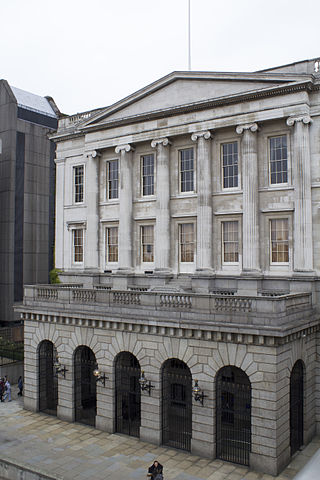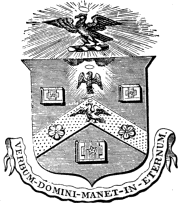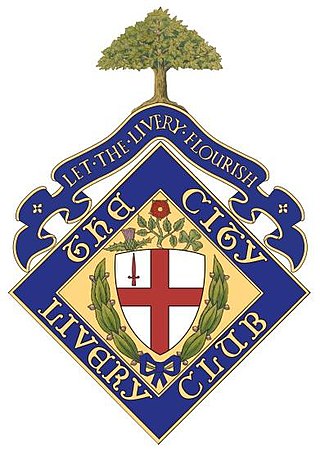
A livery company is a type of guild or professional association that originated in medieval times in London, England. Livery companies comprise London's ancient and modern trade associations and guilds, almost all of which are styled the "Worshipful Company of" their craft, trade or profession. There are 111 livery companies in total. They play a significant part in the life of the City of London, not least by providing charitable-giving and networking opportunities. Liverymen retain voting rights for the senior civic offices, such as the Lord Mayor, Sheriffs and Common Council of the City Corporation, London's ancient municipal authority with extensive local government powers.

The Worshipful Company of Stationers and Newspaper Makers, usually known as the Stationers' Company, is one of the livery companies of the City of London. The Stationers' Company was formed in 1403; it received a royal charter in 1557. It held a monopoly over the publishing industry and was officially responsible for setting and enforcing regulations until the enactment of the Statute of Anne, also known as the Copyright Act 1710. Once the company received its charter, "the company's role was to regulate and discipline the industry, define proper conduct and maintain its own corporate privileges."

The Worshipful Company of Grocers is one of the 111 livery companies of the City of London, ranking second in order of precedence.

The Worshipful Society of Apothecaries of London is one of the livery companies of the City of London. It is one of the largest livery companies and ranks 58th in their order of precedence.

The Worshipful Company of Drapers is one of the 111 livery companies of the City of London. It has the formal name The Master and Wardens and Brethren and Sisters of the Guild or Fraternity of the Blessed Mary the Virgin of the Mystery of Drapers of the City of London. More usually known simply as the Drapers' Company, it is one of the historic Great Twelve Livery Companies and was founded during the Middle Ages.

The Worshipful Company of Vintners, one of the Great Twelve City Livery Companies, retains close links with the wine trade.

The Worshipful Company of Bakers is one of the livery companies of the City of London. The Bakers' Guild is known to have existed in the twelfth century. From the Corporation of London, the Guild received the power to enforce regulations for baking, known as the Assize of Bread and Ale. The violations included selling short-weight bread and the addition of sand instead of flour. The Bread Assize remained in force until 1863, when Parliament repealed it.

The Worshipful Company of Clothworkers was incorporated by Royal Charter in 1528, formed by the amalgamation of its two predecessor companies, the Fullers and the Shearmen. It succeeded to the position of the Shearmen's Company and thus ranks twelfth in the order of precedence of Livery Companies of the City of London.

The Worshipful Company of Pewterers is one of the 111 Livery Companies of the City of London. It ranks 16th in the order of precedence of City Livery Companies and has existed since at least 1348. Like all the other City Livery Companies, the Worshipful Company of Pewterers has four main pillars of activity: Charitable endeavour, assistance to education, support for its trade and profession, and being a convivial and caring social community.

The Worshipful Company of Brewers is one of the ancient livery companies of the City of London.

The Worshipful Company of Butchers is one of the Livery Companies of the City of London, England. Records indicate that an organisation of butchers existed as early as 975; the Butchers' Guild, the direct predecessor of the present Company, was granted the right to regulate the trade in 1331. The Butchers' Guild was incorporated by Royal Charter centuries later, in 1605. The Butchers' still, unlike other Livery Companies, continues to exist as a trade association for members of the industry, instead of evolving into an institution primarily dedicated to charity. However, the Company does contribute, like all Livery Companies, to various charities.
Blackfriars is in central London, specifically the south-west corner of the City of London.

Apothecary is an archaic English term for a medical professional who formulates and dispenses materia medica (medicine) to physicians, surgeons and patients. The modern terms 'pharmacist' and 'chemist' have taken over this role.

Goldsmiths' Hall is a Grade I listed building at the junction of Foster Lane and Gresham Street in the City of London. It has served as an assay office and the headquarters of London's goldsmith guild, the Worshipful Company of Goldsmiths, one of the livery companies of the City of London. The company has been based at this location since 1339, the present building being their third hall on the site.
HMS Wellington is a Grimsby-class sloop, formerly of the Royal Navy. During the Second World War, she served as a convoy escort ship in the North Atlantic. She is now moored alongside the Victoria Embankment, at Temple Pier, on the River Thames in London, England. From 1948 to 2023 she was the headquarters ship of the Honourable Company of Master Mariners, known as HQSWellington. In 2024, she returned to her prefix of HMS Wellington.

St Leonard, Foster Lane, was a Church of England church dedicated to Leonard of Noblac on the west side of Foster Lane in the Aldersgate ward of the City of London. It was destroyed in the Great Fire of 1666 and not rebuilt.

Foster Lane is a short street within Cheap ward, in the City of London, England. It is situated northeast of St Paul's Cathedral and runs southbound Gresham Street to Cheapside.

St Mary Colechurch was a parish church in the City of London destroyed in the Great Fire of London in 1666 and not rebuilt.

The Merchant Taylors' Hall, London is the seat of the Worshipful Company of Merchant Taylors, one of the Twelve Great Livery Companies of the City of London surviving from Mediaeval times.

City Livery Club is a members-only club in the City of London, which was established in June 1914. It is based at Bell Wharf Lane, Upper Thames Street, London EC4R 3TB, in the City of London, a site that it shares with the Little Ship Club.



















